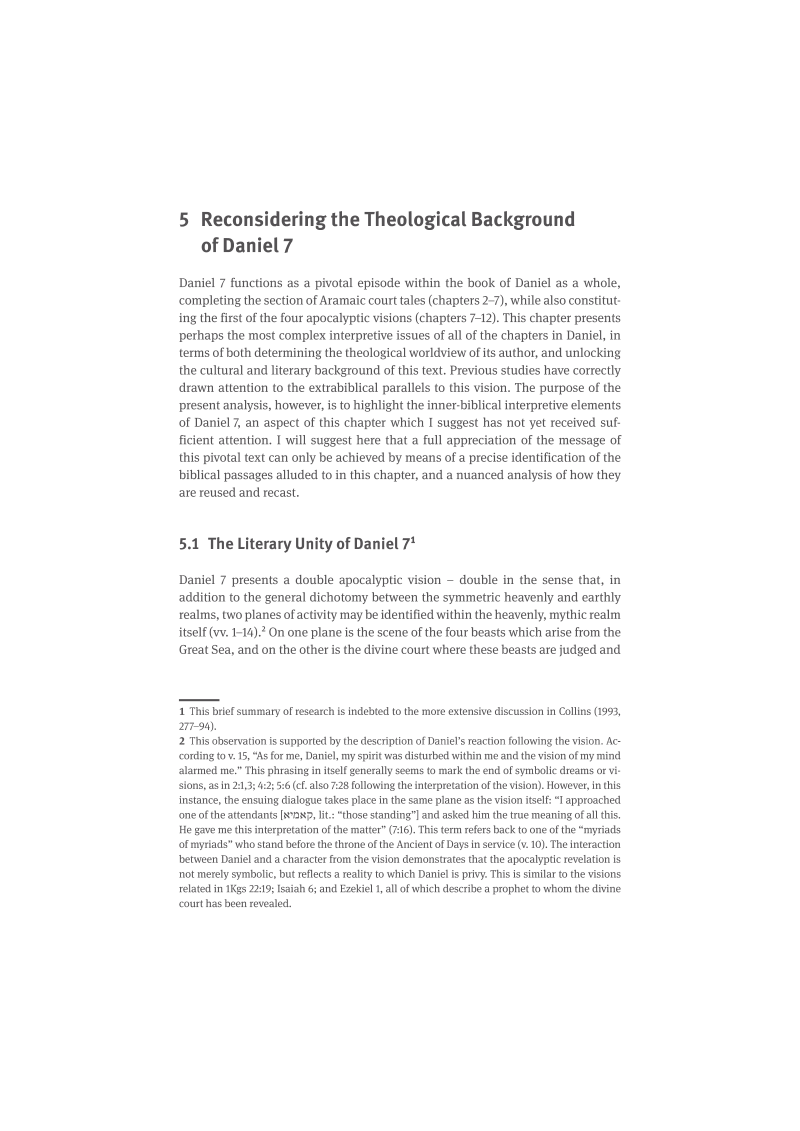Michael Segal argues Yahweh is the Ancient of Days; the "Son of Man" was initially interpreted as the archangel Michael and, in the later Christian tradition, Jesus.
- Type
- Book
- Source
- Michael Segal Non-LDS
- Hearsay
- Direct
- Reference
Michael Segal, Dreams, Riddles and Visions: Textual, Contextual and Intertextual Approaches to the Book of Daniel (Beihefte zur Zeitschrift für die alttestamentliche Wissenschaft 455; Berlin: De Gruyter, 2016), 132-54
- Scribe/Publisher
- Walter de Gruyter
- People
- Michael Segal, Michael
- Audience
- Reading Public
- Transcription
. . . the decision whether to interpret קדישי as a reference to one or multiple divine figures would therefore be a matter of interpretation. The use of the pluralis excellentiae or maiestatis in this phrase is already acknowledged by almost all scholars with reference to the word עליונין. The interpretation proposed here suggests that the same argument can be made regarding the word קדישי. In that case, the phrase may be read “the most high Holy One,” identified as YHWH himself, who stands out among the various divine characters in Daniel 7. The correspondence of the “one like a man” in the vision to the קדישי עליונין in the interpretation would on this reading be eminently plausible—both refer to YHWH, who is to receive eternal dominion and sovereignty. The extended phrase עם קדישי עליונין would then refer to the nation of YHWH, a reference to the people of Israel, who will benefit in the earthly realm from YHWH’s dominion in the heavenly plane. . . .
In the analysis above, it was suggested that one can identity the one like a man, and קדישי עליונין, with YHWH, and the עם קדישי עליונין, with his people, Israel. This identification further strengthens the connection to and transformation of Deuteronomy 32. In that earlier poetic text, YHWH received only a small, yet significant, portion of the nations and lands of the world under his direct care. However, Daniel 7 envisions a transformation of the world order, in which YHWH will be sovereign over all of the nations of the world, thus transforming the nation God of Israel into a universal God to whom all nations will be subservient. Daniel 7 is not intended to replace Deuteronomy 32, since they describe different periods in the history of the world. The first describes the creation of the cosmos, while the second reaches towards a new creation of the theological-cosmological world order. . . .
If the above claim is correct, that Daniel 7 reflects the same contours as the heavenly scenes in Deuteronomy 32 and Psalm 82, in which YHWH received dominion over the world, then subsequent interpretations transformed this theological-cosmological picture, promoting YHWH to the head of this court, and equating him with the Ancient of Days. This promotion, however, created a vacuum for the identification of the one like a man, and opened up the possibility of a new character, a divine second-in-command over Israel, a notion that is developed in subsequent chapters of Daniel (identified as Michael in 10:13,21; 12:1) and in the New Testament (Jesus).
- Citations in Mormonr Qnas
The B. H. Roberts Foundation is not owned by, operated by, or affiliated with the Church of Jesus Christ of Latter-day Saints.

